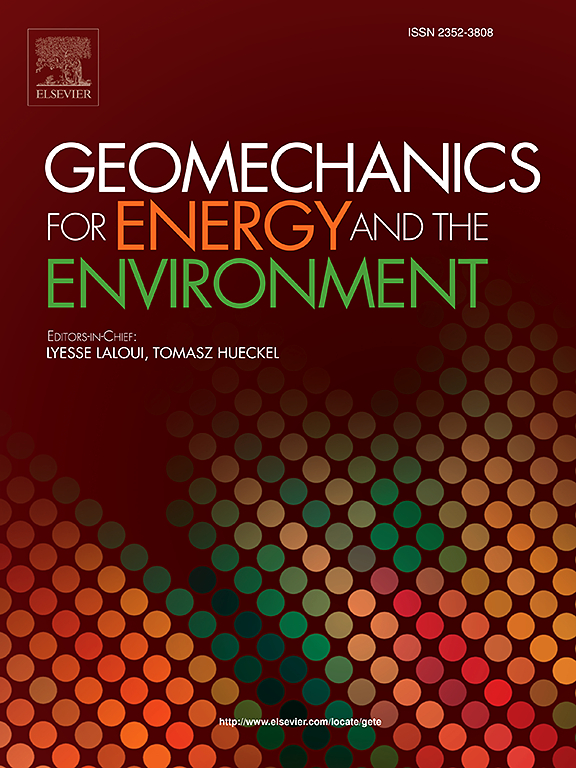粘土中方形与圆形板锚的数值比较
IF 3.7
2区 工程技术
Q3 ENERGY & FUELS
引用次数: 0
摘要
本文提出了在纯粘性土(即不排水条件下的粘土)中方形和圆形锚杆的垂直拔拔能力的数值比较。为简单起见,我们考虑了超薄的无限刚性锚杆,为了隔离锚杆形状的影响,我们对等面积和埋深的锚杆进行了比较。采用有限元极限分析(FELA)计算了全埋置比范围内破坏因子的上限和下限,并确定了相关的破坏机制。结果首次表明(据作者所知),由于方形锚的周长较大,在浅埋比下,方形锚的效率略高,而在更深的深度下,圆形锚由于不同的破坏机制而效率更高。该研究还探讨了锚杆倾角的影响,结果表明,由于锚杆的破坏机制拉长,在通风条件下,倾斜锚杆具有更高的拔出能力。在附加条件下,大多数情况下均可得到深部破坏机理,并具有相应的恒定破裂因子。此外,本文还分析了锚群中锚间距的影响,确定了最优的锚间距,以避免因相互作用而导致的承载力下降。对于较浅的深度,大约两倍锚固宽度的间距就足够了,而较深的安装需要更大的间距,因为破坏区域会扩大。一旦达到深部破坏机制,间距要求再次降低,小于锚固宽度的两倍。总的来说,所提出的数值模拟为粘性土壤中板锚的设计提供了见解,有助于海洋基础技术的进步。本文章由计算机程序翻译,如有差异,请以英文原文为准。
Numerical comparison between square and circular plate anchors in clay
This paper presents a numerical comparison of the vertical pull-out capacity of square and circular anchors in purely cohesive soils (i.e. clays in undrained conditions). For simplicity, ultrathin, infinitely rigid anchors are considered and to isolate the effect of anchor shape, comparisons are made between anchors of equal area and embedment depth. Finite Element Limit Analyses (FELA) are used to compute upper and lower bound values of the break-out factor over the full range of embedment ratios, and the associated failure mechanisms are identified. The results show for the first time (to the best of the authors’ knowledge) that square anchors exhibit slightly higher efficiency at shallow embedment ratios due to their larger perimeter, while at greater depths, circular anchors become more efficient as a result of the different failure mechanisms involved. The study also investigates the influence of anchor inclination and shows that inclined anchors have a higher pull-out capacity in vented conditions due to elongated failure mechanisms. Under attached conditions, the deep failure mechanism is obtained in most cases with the corresponding constant break-out factor. In addition, the paper analyses the influence of anchor spacing in anchor groups, identifying optimal spacing to avoid capacity reduction due to interaction effects. For shallow depths, a spacing of about two times the anchor width is sufficient, while deeper installations require larger spacings due to the extended failure zone. Once the deep failure mechanism is reached, spacing requirements decrease again, less than two times the anchor width. Overall, the presented numerical simulations offer insights for the design of plate anchors in cohesive soils, contributing to the advancement of offshore foundation technologies.
求助全文
通过发布文献求助,成功后即可免费获取论文全文。
去求助
来源期刊

Geomechanics for Energy and the Environment
Earth and Planetary Sciences-Geotechnical Engineering and Engineering Geology
CiteScore
5.90
自引率
11.80%
发文量
87
期刊介绍:
The aim of the Journal is to publish research results of the highest quality and of lasting importance on the subject of geomechanics, with the focus on applications to geological energy production and storage, and the interaction of soils and rocks with the natural and engineered environment. Special attention is given to concepts and developments of new energy geotechnologies that comprise intrinsic mechanisms protecting the environment against a potential engineering induced damage, hence warranting sustainable usage of energy resources.
The scope of the journal is broad, including fundamental concepts in geomechanics and mechanics of porous media, the experiments and analysis of novel phenomena and applications. Of special interest are issues resulting from coupling of particular physics, chemistry and biology of external forcings, as well as of pore fluid/gas and minerals to the solid mechanics of the medium skeleton and pore fluid mechanics. The multi-scale and inter-scale interactions between the phenomena and the behavior representations are also of particular interest. Contributions to general theoretical approach to these issues, but of potential reference to geomechanics in its context of energy and the environment are also most welcome.
 求助内容:
求助内容: 应助结果提醒方式:
应助结果提醒方式:


